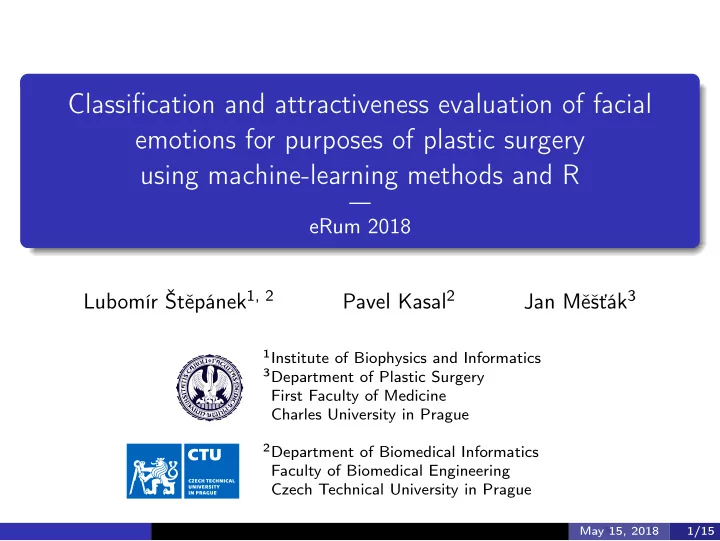

Classification and attractiveness evaluation of facial emotions for purposes of plastic surgery using machine-learning methods and R — eRum 2018 Lubomír Štěpánek 1, 2 Pavel Kasal 2 Jan Měšťák 3 1 Institute of Biophysics and Informatics 3 Department of Plastic Surgery First Faculty of Medicine Charles University in Prague 2 Department of Biomedical Informatics Faculty of Biomedical Engineering Czech Technical University in Prague May 15, 2018 1/15
Introduction Methodology Results Summary Obsah Introduction 1 Methodology 2 Results 3 Summary 4 Lubomír Štěpánek Classification and attractiveness evaluation of facial emotions May 15, 2018 2/15
Introduction Methodology Results Summary Quick introduction human facial attractiveness perception is data-based and irrespective of the perceiver current plastic surgery deals with aesthetic indications such as an improvement of the attractiveness of a smile or other facial emotions Lubomír Štěpánek Classification and attractiveness evaluation of facial emotions May 15, 2018 3/15
Introduction Methodology Results Summary Quick introduction total face impression is also dependent on presently expressed facial emotion there is no face without facial emotion at all Lubomír Štěpánek Classification and attractiveness evaluation of facial emotions May 15, 2018 4/15
Introduction Methodology Results Summary Aims of the study to identify geometric features of a face associated with an increase of facial attractiveness after undergoing rhinoplasty to explore how accurate classification of faces into sets of facial emotions and their facial manifestations is Lubomír Štěpánek Classification and attractiveness evaluation of facial emotions May 15, 2018 5/15
Introduction Methodology Results Summary Brief methodology of facial attractiveness evaluation profile facial image data were collected for each patient before and after rhinoplasty (about 80 images) images were processed landmarked analyzed linear regression was performed to select predictors increasing facial attractiveness after undergoing rhinoplasty Lubomír Štěpánek Classification and attractiveness evaluation of facial emotions May 15, 2018 6/15
Introduction Methodology Results Summary Brief methodology of facial emotions classification portrait facial image data were collected for each person just in the moment they show a facial expression according to the given incentive (about 170 images) images were processed landmarked analyzed Bayesian naive classifiers, regression trees (CART) and neural networks were learned to allow assigning a new face image data into one of facial emotions Lubomír Štěpánek Classification and attractiveness evaluation of facial emotions May 15, 2018 7/15
Introduction Methodology Results Summary Data of interest facial attractiveness of patients’ cluster of emotions quality contact positive data was measured using Likert helpfulness positive scale by a board of independent evocation positive observers defence negative aggression negative the sets of used facial emotions reaction neutral decision neutral and other facial manifestation well-being positive originate from Ekman-Friesen fun positive FACS scale, but was improved rejection negative depression negative substantially fear negative deliberation positive expectation positive Lubomír Štěpánek Classification and attractiveness evaluation of facial emotions May 15, 2018 8/15
Introduction Methodology Results Summary Landmarking Lubomír Štěpánek Classification and attractiveness evaluation of facial emotions May 15, 2018 9/15
Introduction Methodology Results Summary Some derived metrics and angles metrics/angles definition nasofrontal angle angle between landmarks 2, 3, 18 (profile) nasolabial angle angle between landmarks 7, 6, 17 (profile) nasal tip horizontal Euclidean distance between landmarks 6, 5 (profile) nostril prominence Euclidean distance between landmarks 15, 16 (profile) cornea-nasion distance horizontal Euclidean distance between landmarks 3, 4 (profile) outer eyebrow Euclidean distance between landmarks 21, 22 (portrait) inner eyebrow Euclidean distance between landmarks 25, 26 (portrait) lower lip Euclidean distance between landmarks 30, 33 (portrait) mouth height Euclidean distance between landmarks 6, 8 (profile) angular height Euclidean distance between landmarks 7 (or 8) and 33 (portrait) Lubomír Štěpánek Classification and attractiveness evaluation of facial emotions May 15, 2018 10/15
Introduction Methodology Results Summary Evaluation of rhinoplasty effect on facial attractiveness predictor estimate t -value p -value intercept after-before 3.832 1.696 0.043 nasofrontal angle after-before 0.353 1.969 0.049 nasolabial angle after-before 0.439 1.986 0.047 nasal tip after-before -3.178 0.234 0.068 nostril prominence after-before -0.145 0.128 0.266 cornea-nasion distance after-before -0.014 0.035 0.694 Lubomír Štěpánek Classification and attractiveness evaluation of facial emotions May 15, 2018 11/15
Introduction Methodology Results Summary Trees for prediction of the cluster & quality of emotions Lubomír Štěpánek Classification and attractiveness evaluation of facial emotions May 15, 2018 12/15
Introduction Methodology Results Summary Predictions of the emotional quality based on the naive Bayes classifiers, CART’s and neural networks, respectively predicted class negative neutral positive negative 34 11 16 true class neutral 16 39 8 positive 4 10 30 predicted class negative neutral positive negative 35 7 15 true class neutral 12 40 9 positive 4 12 31 predicted class negative neutral positive negative 36 6 6 true class neutral 12 54 18 positive 3 4 32 Lubomír Štěpánek Classification and attractiveness evaluation of facial emotions May 15, 2018 13/15
Introduction Methodology Results Summary Summary enlargement of both a nasolabial and nasofrontal angle within rhinoplasty were determined as statistically significant predictors increasing facial attractiveness neural networks manifested the highest predictive accuracy of a new face categorization into facial emotions geometrical shape of mouth, then eyebrows and finally eyes affect in descending order the intensity of classified emotion Lubomír Štěpánek Classification and attractiveness evaluation of facial emotions May 15, 2018 14/15
Thank you for your attention! lubomir.stepanek@lf1.cuni.cz lubomir.stepanek@fbmi.cvut.cz Lubomír Štěpánek Classification and attractiveness evaluation of facial emotions May 15, 2018 15/15
Recommend
More recommend